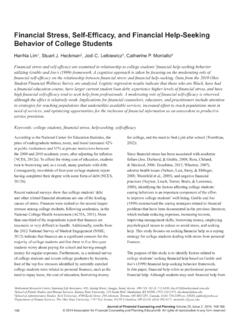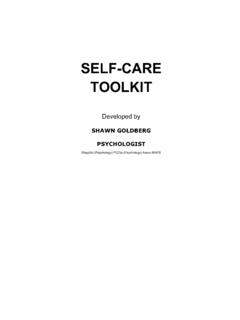Transcription of Making the difference together - GOV.UK
1 Making the difference togetherGuidance on gathering and using feedback about the experience of social work from people who use services and their carersJanuary 2016 Making the difference togetherGuidance on gathering and using feedback about the experience of social work from people who use services and their carersDr Ruth AllenDr Sarah CarrDr Karen Lindewith Hari SewellWith thanks for their contributions to:Dorothy Gould, Service user Nicholas, Robert Punton and Clenton Farquharson, Community Navigator Services User-led Training and Development may re-use the text of this document (not including logos) free of charge in any format or medium, under the terms of the Open Government Licence. To view this licence, visit Crown copyright Published to , in PDF format 1C h a pte r 1: Service user and carer feedback within the Social Work for Better Mental Health initiative 3 Chapter 2: Developing this guidance 5 Chapter 3: Guidance One: Implementing a tailored Experience of social work feedback questionnaire 9 Chapter 4: Guidance Two: Gathering feedback through collaborative conversations about practice between social workers and people using services or carers 19 References 25 Appendix One: Service user feedback questionnaire 29 Appendix Two.
2 Carer feedback questionnaire 39 IntroductionIntroduction 1 This document provides guidance on practical ways to gather and use direct feedback about people s experiences of social work practice within mental health services. It is aimed at social workers, their supervisors, managers and workforce leads. It is also aimed at people using services and their carers or families because they should be involved in co-producing approaches to integrating direct feedback into social work practice and service improvement from the outset. The importance of using direct feedback to evaluate the quality of practice at the level of individual practitioners is increasingly recognised across the health and care professions in England. Services user feedback is central to medical revalidation and the new nurse revalidation process. It is already a core requirement of social work qualifying training, it is included in the Assessed and Supported Year in Employment assessment process and embedded in Approved Mental Health Professional training.
3 However, it is not a routine activity (neither by custom not by regulatory requirement) for most qualified social workers in day to day practice. While social workers recognise the value of understanding the lived experience of people with mental health conditions to promote empowerment and service user voice and choice, practitioners and supervisors do not routinely or formally use service users (and carers ) views about the practice as part of reflective learning. Social work should be a user-led (and carer/family-led) profession this is at the core of our professional ethics and perspective. The Social Work Reform Board service user and carer consultation on social work reported that: the overriding message from the responses was that service user and carer input must be an essential part of any developments and ongoing work. It was stressed that it is important that this is seen as an integral part of social work training and development and not an add-on (Social Work Reform Board, 2010 p1)Service user and carer feedback can inform critical reflection, individual supervision, appraisal and continuing professional development.
4 Individual and group feedback can be collated and analysed to measure and improve individual, team and organisational performance against practice standards ( the Professional Capabilities Framework). Direct feedback enables us to assess the quality of working relationships between service users, carers and practitioners and it can be used to improve people s experiences of processes and relationships as well as outcomes as service users and families often say, it is not just what social workers do but how they provide support and the relationship context that is so important for recovery and Service user and carer feedback within the Social Work for Better Mental Health initiative 3 Chapter 1: Service user and carer feedback within the Social Work for Better Mental Health The Social Work for Better Mental Health (SWfBMH) initiative proposes that direct service user and carer feedback on practice should be explicitly embedded in local mental health social work workforce and practice development frameworks.
5 There are a variety of reasons for this, most particularly: To find out directly what people find beneficial/detrimental. To learn and make changes in practice from both positive and critical feedback. To enhance service users and carers opportunities to influence practice and the definition of quality support from the professionals who service them as citizens. To identify locally what is found to be distinctive or valuable about social work within multi-professional systems, thus supporting the definition of the social work role vis a vis other professionals. To support and maintain reflective practice throughout the career of practitioners. To support the content of effective and creative supervision and appraisal for staff through providing a framework for them to present and discuss service user and carer feedback. To provide managers and practice leaders with useful service user, carer and family experience and service quality information regarding individual practitioners and/or groups of staff.
6 To provide a platform for further service user, carer and family involvement in staff development activities informing curricula of workforce plans and training courses which may include service users or carers in delivery. To provide information about whether conditions for good practice are being set gaining feedback from service users and carers about the amount of time staff have available to spend with them or the frequency of contact, or whether social workers appear rushed or inattentive which may relate to stress, caseload or workflow management Developing this guidance 5 Chapter 2: Developing this This guidance is based on research into what service users and carers value and find effective in social work practice; research literature on service user quality of life indicators and recovery measures; practice feedback tools from social work education and patient satisfaction surveys from general and mental health.
7 It also incorporates consultation responses from senior mental health social work leaders. The background research for this guidance and the development of the feedback questionnaires has been has been undertaken by Dr Sarah Carr, mental health service user consultant and Associate Professor of Mental Health Research at Middlesex University, working with the other SWfBMH authors1 on the final guidance. The document also draws on consultation material gained specifically for this project from other Experts by Experience. There are many possible approaches to gaining service user and carer feedback, and this guidance is not a definitive approach to cover all situations. Each service system needs to consider with service user and carer partners what approaches most suit their There is, of course, an existing evidence-base on the principles and practice of administering service user experience and satisfaction feedback tools.
8 The Picker Institute evidence review and consultation 1 Dr Ruth Allen, Dr Karen Linde and Hari the following recommendations for approaching service user feedback, which must be: Tailored to the professional [and] service user groups. Designed according to judgements about the capacity and willingness of a particular service user group to respond to a particular form of [feedback] assessment: a standard format questionnaire , story -telling, supported conversation, or a face-to-face evaluation, bearing in mind the costs and benefits of Service users should be able to choose between methods of feedback according to their communication abilities and preferences but in practice this may be difficult to implement. (Chisholm & Sheldon, 2011 p2-3) Speaking of student social workers, the College of Social Work (TCSW) noted that there is no single way in which students of social workers should seek feedback from people they work with (now closed), suggesting that a choice of several approaches may be relevant including: questionnaire , online survey or feedback forms (including open-ended questions).
9 Direct observations (of practice). Gathering feedback over time (verbal and non-verbal, formal and informal). Supervision Making the difference together Guidance on gathering and using feedback about the experience of social work from people who use services and their carers Feedback from other people involved; Work products and records. Critical reflection and storytelling.(adapted from TCSW, no date) This document proposes two specific approaches to gaining service user and carer or family feedback: Implementing a tailored Experience of social work feedback questionnaire for service users and carers (see Appendices 1 and 2). Gathering feedback through collaborative conversations between social workers and people using services or their carers. Guidance One: The experience of social work feedback questionnaire2 .7. The first of these approaches was chosen because, while there is an evidence base for the development and use of service user feedback questionnaires in mental health generally, there is no pre-existing tailored tool for mental health social work.
10 A questionnaire is useful because it can be used by an individual or it can be administered across a workforce and the results aggregated and analysed for trends etc. Anonymity may be offered and this is often very important to enable service users and carers to feel safe enough to provide feedback. But a questionnaire can also be used with a named individual and/or it can be used to find out about a specific social worker or a group of staff. The questionnaire content provided here is derived from research into what we know is often important to service users and carers in their encounters with social workers (and other mental health staff) and thus the questionnaire itself may be a useful topic guide for further exploration of service user and carer views and experiences at the individual level, where A questionnaire can be tested for validity and reliability over time to gauge its usefulness and accuracy in providing feedback across settings.


















